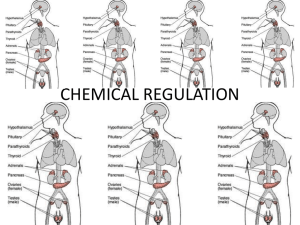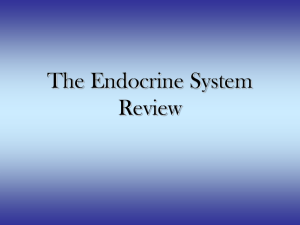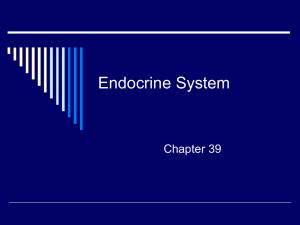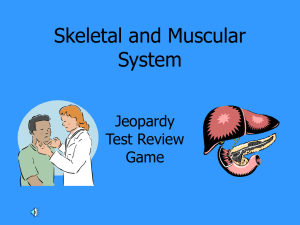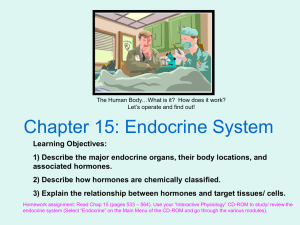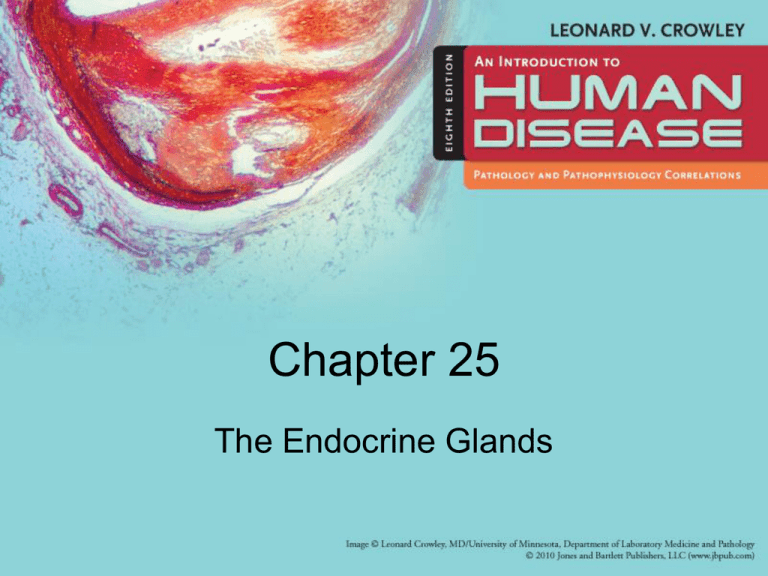
Chapter 25
The Endocrine Glands
Learning Objectives (1 of 2)
• Explain normal physiologic functions of pituitary
hormones, common endocrine disturbances, and
treatment
• Describe major thyroid abnormalities, clinical
manifestations, and treatment
• Explain normal physiologic functions of adrenal
cortex and medulla, common disturbances, and
treatment
• Define causes and effects of parathyroid
dysfunction and treatment
Learning Objectives (2 of 2)
• Discuss concept of ectopic hormone
production by nonendocrine tumors
• Explain adverse health effects of obesity,
surgical procedures for obesity and their
rationale
• Explain stress and its effects on the
endocrine system
Endocrine Glands (1 of 2)
• Major endocrine glands
– Pituitary
– Thyroid
– Parathyroid
– Adrenal cortex and medulla
– Pancreatic islets
– Ovaries and testes
Endocrine Glands (2 of 2)
• Level of hormone in circulation: controls
amount of hormone synthesized and released
by an endocrine gland
• Disorders: hypersecretion or hyposecretion
• Determination of clinical effects
– Degree of dysfunction
– Age and sex of affected individual
Pituitary Gland (1 of 6)
• Suspended by stalk from hypothalamus at base of
brain
– Anterior lobe
– Intermediate lobe: rudimentary structure
– Posterior lobe
• Tropic hormones (regulate other endocrine glands)
– Regulated by level of hormone produced by the target
gland
– Self-regulating mechanism maintains uniform hormone
output
– Prolactin secretion controlled by prolactin inhibitory factor
– Thyroid stimulating hormone stimulates release of prolactin
and thyroid hormones
Pituitary Gland (2 of 6)
• Anterior lobe hormones
– Growth hormone: stimulates growth of tissues
– Prolactin: stimulates milk production
– Thyroid-stimulating hormone (TSH)
– Adrenocorticotrophic hormone (ACTH)
– Follicle-stimulating hormone (FSH)
– Luteinizing hormone (LH)
• Posterior lobe hormones
– Antidiuretic hormone (ADH): causes more
concentrated urine
– Oxytocin: stimulates uterine contractions and
milk secretion
Normal mechanisms controlling elaboration of
tropic hormones by the pituitary gland
Pituitary Gland (3 of 6)
• Panhypopituitarism
– Anterior lobe fails to secrete all hormones
• Pituitary dwarfism
– Deficiency of growth hormone
– Causes retarded growth and development
• Diabetes insipidus
– Failure of posterior lobe to secrete ADH or failure of
kidney to respond to ADH (nephrogenic diabetes
insipidus)
– Unable to absorb H2O
– Causes excretion of large amounts of diluted urine
– From a pituitary tumor
Pituitary Gland (4 of 6)
• Growth hormone overproduction
–
–
–
–
Caused by pituitary adenoma
Causes gigantism in children
Causes acromegaly in adults
May cause visual disturbances from tumor
encroachment in optic chiasm
• Prolactin overproduction
– Result of small pituitary adenoma
– Also from conditions affecting function of hypothalamus
– Causes amenorrhea and galactorrhea (milk secretion
from non-pregnant breasts)
Pituitary Gland (5 of 6)
• Pituitary tumors
– Many pituitary endocrine disturbances caused by
anterior lobe pituitary tumors
– Clinical manifestations depend on size of tumor
and the hormone produced
• Functional tumors: produce hormones that cause
clinical manifestations
• Nonfunctional tumors: do not produce hormones but
exert other effects
• May encroach on important structures adjacent to
optic chiasm; disrupt hormone-producing functions of
anterior lobe cells
Pituitary Gland (6 of 6)
• Pituitary tumors
– Treatment determined by type, size, and
hormone produced by tumor
• Drugs to suppress tumor growth
• Surgical resection: usual surgical approach is
through the nasal cavity (transsphenoidal resection)
Acromegaly
© Courtesy of Leonard Crowley, M.D./University of Minnesota Medical School
Factors regulating prolactin secretion and
pathogenesis of amenorrhea-galactorrhea syndrome
Transsphenoidal resectin of a pituitary tumor
Thyroid Gland
• Structure
– Two lateral lobes connected by isthmus
– Composed of thyroid follicles that produce
and store hormones
– Hormone production regulated by TSH
(thyroid stimulating hormone)
– Parafollicular cells: secrete calcitonin
• Actions
– Controls rate of metabolic processes
– Required for normal growth and
development
Normal thyroid gland, illustrating two lateral
lobes connected by narrow isthmus
Low-magnification photomicrograph of
cellular structure of normal thyroid gland.
High-magnification photomicrograph of
normal thyroid follicles.
Thyroid Gland
Hyperthyroidism
Hypothyroidism
Rapid pulse
Slow pulse
Increased metabolism
Decreased metabolism
Hyperactive reflexes
Sluggish reflexes
Emotional lability
Placid and phlegmatic
GI effect: diarrhea
GI effect: constipation
Warm, moist skin
Cold, dry skin
Nontoxic Goiter
• Thyroid gland enlarges to increase hormone
secretion
• Causes
–
–
–
–
–
Inadequate hormone output
Iodine deficiency
Enzyme deficiency
Inefficient enzyme function
Increased hormone requirements
• Treatment: administer thyroid hormone; may
need surgical removal
The pathogenesis of nontoxic goiter
Hyperthyroidism
• Toxic goiter or Graves disease
• Caused by antithyroid antibody that
stimulates gland
• Mimics effects of TSH but not subject to
normal control mechanisms
• Treatment
– Antithyroid drugs, thyroidectomy, large
doses of radioactive iodine
Toxic Goiter
Nodular goiter obstructing veins draining
blood from head, neck, and chest.
Large nodular goiter
Hypothyroidism
• In adult
– Myxedema
– Causes metabolic slowing
– Treatment: administration of thyroid hormone
• In an infant
–
–
–
–
Cretinism
Causes impaired growth and CNS development
Causes hypometabolism
Early diagnosis and treatment required for normal
development
The characteristic appearance of neonatal
hypothyroidism (cretinism) as a result of a congenital
absence of thryroid gland.
Myxedema
Chronic Thyroiditis or Hashimoto
Thyroiditis
• Autoantibody destroys thyroid tissue
• Results in hypothyroidism
• An immunologic reaction, not from an
infection
• Cellular infiltration from an immunologic
reaction between antigen and antibody
Low-magnification photomicrograph of
cellular structure in chronic thyroiditis.
Thyroid Tumors
• Benign adenoma
• Carcinoma
– Well-differentiated follicular and papillary
carcinoma
• Good prognosis; treatment by surgical resection
– Poorly-differentiated carcinoma
• Poor prognosis; rapidly growing
• Treatment: surgery, radiation, chemotherapy
– Medullary carcinoma
• Rare, secretes calcitonin
Radiation and Thyroid Tumors
• Radiation: increases incidence of benign and
malignant thyroid tumors after latent period of
5-10 years
• Most tumors are well-differentiated and easily
treated
• Persons who received head or neck radiation
should have periodic follow-up examinations
A benign, well-circumscribed adenoma of
the thyroid gland (arrows).
Well-differentiated papillary carcinoma of thyroid.
Higher magnification.
Parathyroid Glands
• Blood calcium level is in equilibrium with calcium
in the bone
• Actions: Calcium level: regulated by parathyroid
glands
– Low calcium in blood: causes tetany (increased
neuromuscular excitability causing spasm of skeletal
muscle)
– High calcium in blood: causes lowered neuromuscular
excitability
Hyperparathyroidism
• Usually from a hormone-secreting
parathyroid adenoma
• Effects
– Hypercalcemia: blood calcium rises
– Renal calculi: from excessive calcium excreted
in urine
– Calcium deposition in tissues
– Decalcification of bone: from excessive
calcium withdrawn from bone
• Treatment: Removal of tumor
Hypoparathyroidism
• Usually from accidental removal of
parathyroid glands during thyroid surgery
• Effects
– Hypocalcemia: blood calcium falls precipitously
– Leads to neuromuscular excitability and tetany
• Treatment: raise calcium levels
– High-calcium diet
– Supplementary vitamin D
Adrenal Cortex (1 of 2)
• Adrenals: paired glands above kidneys
• Hormones secreted by adrenal cortex
–
–
–
–
–
Glucocorticoids
Mineralocorticoids
Aldosterone: major hormone
Renin-angiotensin system is main stimulus
Sex hormones
• Overproduction of aldosterone
– From aldosterone-producing tumor of adrenal cortex
– High sodium, blood volume, blood pressure
– Low potassium level leading to neuromuscular
manifestations
Adrenal Cortex (2 of 2)
• Overproduction of adrenal sex hormones
– Congenital adrenal hyperplasia
– Sex-hormone-producing tumors
Adrenal Medulla
• Produces catecholamines that stimulate the
sympathetic nervous system
– Norepinephrine (noradrenaline)
– Epinephrine (adrenaline)
• Pheochromocytoma: increased secretion of
catecholamines
– Produces pronounced CV effects
– May cause cerebral hemorrhage from
hypertension
– Any emotional stress causes release of
hormones
– Treatment: tumor resection
Biosynthesis of adrenal cortical hormones and the site
of enzymatic block leading to overproduction of adrenal
androgens.
Addison Disease
• An adrenal cortical hypofunction
• Deficiency of all steroid hormones
– Glucocorticoid deficiency: hypoglycemia
– Mineralocorticoid deficiency: lowblood volume
and low blood pressure
– Hyperpigmentation: from increased ACTH
due to loss of feedback inhibition
• Autoimmune disorder
– Treatment: administration of corticosteroids
Appearance of hand (right side of photograph) of patient
with Addison’s disease compared with hand of normal
subject.
Cushing Disease
• Excessive production of adrenal corticosteroids
– Glucocorticoid excess: disturbed carbohydrate, fat, and
protein metabolism
– Mineralocorticoid excess: high blood volume and high
blood pressure
– Treatment: tumor removal
• Causes
–
–
–
–
–
Hormone-producing pituitary microadenoma
Hormone-producing adrenal cortex adenoma
Hyperplastic adrenal glands
Administration of large amounts of corticosteroid
Other tumors
Cushing’s disease before treatment.
Cushing’s disease after treatment.
Overproduction of Other Adrenal
Cortex Hormones
• Overproduction of aldosterone
– Aldosterone secreting adenoma
• Overproduction of adrenal sex hormones
– Congenital adrenal hyperplasia
– Adrenal sex-hormone–producing tumor
Pancreatic Islets
• Pancreatic tissue that functions as an
endocrine gland
• Produce hormones
– Beta cells: insulin production
– Alpha cells: glucagon
– Delta cells: somatostatin
Gonads
• Function
– Production of germ cells
– Production of sex hormones: controlled by
gonadotropic hormones of pituitary gland FSH
and LH
• Tumors may secrete hormones
• Treatment: surgical excision
Nonendocrine Tumors
• Ectopic hormones: hormones secreted by
nonendocrine tumors that are identical with or
mimic action of true hormones
• Usual origin: produced by malignant tumors
• Lung, pancreas, kidneys, connective tissue
Stress and Endocrine System
• Stress: any event that disturbs homeostasis
• Causes: injury, surgery, prolonged exposure to
cold, vigorous exercise, pain, or strong emotional
stimulus such as anxiety or fear
• Acute response to stress
– Fear-fight-flight reaction
– Mediated by sympathetic nervous system and adrenal
medulla
• Chronic response to stress: alters metabolism,
taxes CV system, impairs inflammatory and
immune responses
– Involves adrenal cortex; predisposes to illness
Obesity (1 of 2)
• Occurs when caloric intake >
requirements
• Usually NOT result of endocrine or
metabolic disturbance
• Health consequences
– Cardiovascular disease
– Diabetes
– Cancer
– Musculoskeletal problems
– Impaired pulmonary function
Obesity (2 of 2)
• Treatment
• Medical: diet
• Drugs: suppress appetite
– Combination of fenfluramine and phentermine
(fen-phen) causes heart valve damage
• Surgery
– Ileal bypass: several complications,
infrequently performed
– Gastric bypass
– Vertical-banded gastroplasty
Types of Bariatric Surgery
Discussion
• What are the major hormones produced
by the pituitary gland?
• What are the major effects of abnormal
output of thyroid hormone?
• What is the usual cause of obesity and its
complications?






